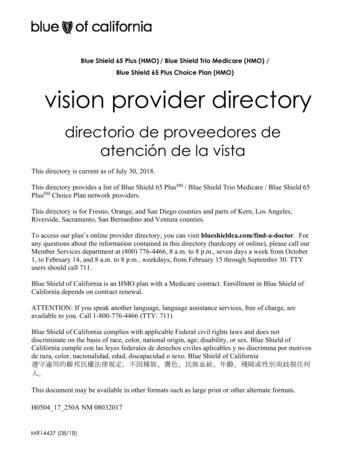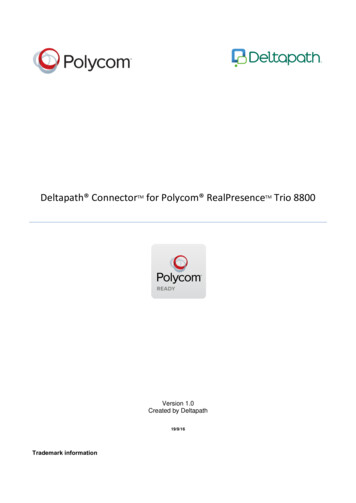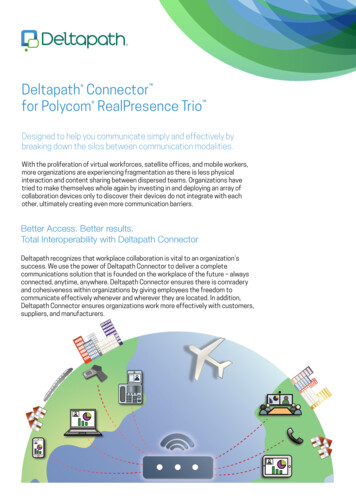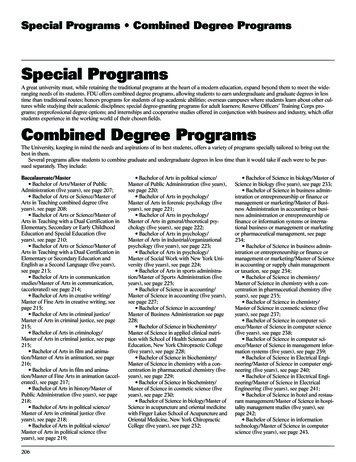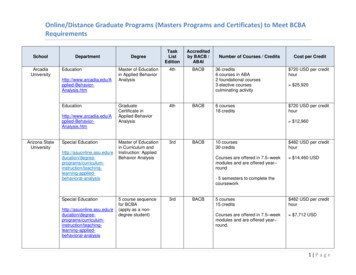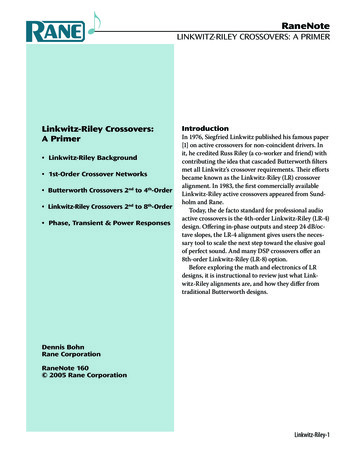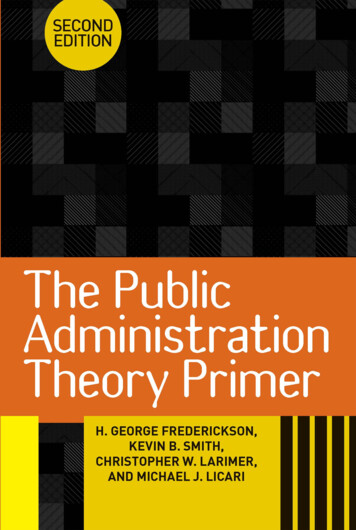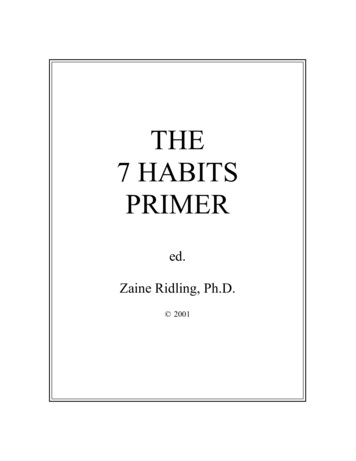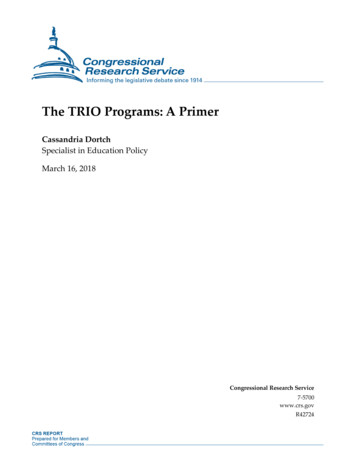
Transcription
The TRIO Programs: A PrimerCassandria DortchSpecialist in Education PolicyMarch 16, 2018Congressional Research Service7-5700www.crs.govR42724
The TRIO Programs: A PrimerSummaryThe TRIO programs are the primary federal programs providing support services todisadvantaged students to promote achievement in postsecondary education. The HigherEducation Amendments of 1968 (P.L. 90-575) consolidated a “trio” of programs under oneoverall program. This report provides a description of the TRIO programs, authorized in Title IVA-2-1 of the HEA.In FY2017, the TRIO programs were funded at 950 million, and they served more than 800,000secondary, postsecondary, and adult students. The TRIO programs have been designed toencourage and prepare qualified individuals from disadvantaged backgrounds for successthroughout the educational pipeline from secondary school to undergraduate and graduateeducation. While the TRIO programs primarily serve low-income, first-generation collegestudents, they also serve students with disabilities, veterans, homeless youth, foster youth, andindividuals underrepresented in graduate education. The TRIO programs are also designed toaward prior grantees that implement successful projects and propose high-quality projects withsubsequent grants before awarding applicants without prior TRIO experience.There are now six TRIO programs, each serving a different demographic. The TRIO UpwardBound (UB) Program serves secondary school students, providing relatively intensive preparationservices and encouragement to help students pursue education beyond secondary school. TheTRIO Talent Search (TS) Program provides less intensive services than UB in support of thecompletion of high school and enrollment in postsecondary education, and it encouragesprimarily students and out-of-school youth. The TRIO Educational Opportunity Centers (EOC)Program primarily serves adults. The TRIO Student Support Services (SSS) Program aims tomotivate undergraduate students to complete their undergraduate education. The Ronald E.McNair Postbaccalaureate Achievement (McNair) Program prepares undergraduate students forgraduate school. Finally, the TRIO Staff Development (Training) Program trains TRIO projectstaff to be more effective.Several key TRIO program provisions were amended by the Higher Education Opportunity Act(HEOA; P.L. 110-315) in 2008. Two key HEOA amendments address issues pertaining to theapplication review process: scoring and second reviews (appeals). The first amendment definedoutcome criteria that require the Secretary and each grantee to agree upon objectives/targets forthe criteria. The extent to which grantees meet or exceed these objectives determines the numberof prior experience (PE) points the grantee may earn as part of its application in the next grantcompetition. Earning more PE points increases the likelihood of funding. The second amendmentestablished an application review process by which those unsuccessful applicants that can identifya specific technical, administrative, or scoring error may have their applications reviewed asecond time (appealed). The FY2012 TRIO UB competition was the first to use the revisedapplication review process.Congressional Research Service
The TRIO Programs: A PrimerContentsBackground . 1Pipeline of TRIO Programs . 2TRIO Upward Bound (UB) Program . 2Eligible Recipients . 2Program Participants . 3Program Intensity and Activities . 3Outcome Criteria. 4TRIO Talent Search (TS) Program . 5Eligible Recipients . 6Program Participants . 6Program Intensity and Activities . 6Outcome Criteria. 6TRIO Educational Opportunity Centers (EOC) Program . 7Eligible Recipients . 7Program Participants . 7Program Intensity and Activities . 7Outcome Criteria. 8TRIO Student Support Services (SSS) Program . 8Eligible Recipients . 8Program Participants . 8Program Intensity and Activities . 8Outcome Criteria. 9Ronald E. McNair Postbaccalaureate Achievement (McNair) Program . 10Eligible Recipients . 10Program Participants . 10Program Intensity and Activities . 10Outcome Criteria. 10TRIO Staff Development (Training) Program .11Eligible Recipients .11Program Participants .11Program Intensity and Activities .11Outcome Criteria.11Comparison of Key Features of the TRIO Programs . 12Program Appropriations and Project Participants . 14Major HEOA Amendments to Common TRIO Provisions . 18Required Program Activities . 18Prior Experience Points . 18Student-Serving TRIO Programs . 18TRIO Training. 20Application Review Process (Appeal) . 21Award Amounts and Numbers of Program Participants . 21Length of Grant Award . 21Multiple Grants for Different Populations . 22Research, Evaluation, and Assessments . 22SSS Independent Evaluations . 23AY1991-1992 Freshman SSS Participants. 23Congressional Research Service
The TRIO Programs: A Primer2006 SSS Promising Practices . 24AY2007-2008 Freshman SSS Participants. 25SSS PART Reviews and Annual Performance Report Data . 25UB Independent Evaluations . 26UB PART Review and Annual Performance Report Data . 28TS Evaluations . 29TS PART Review and Annual Performance Report Data . 30EOC Evaluations . 30EOC PART Review and Annual Performance Report Data . 30McNair Independent Evaluations . 31McNair PART Review and Annual Performance Report Data . 31Training Evaluations . 31TablesTable 1. TRIO Program Eligible Grant Recipients . 12Table 2. Comparison of the Required Program Participant Demographics across the TRIOPrograms . 12Table 3. Comparison of the Required Program Activities for the Student Serving TRIOPrograms . 13Table 4. TRIO Appropriations and Program Allocations: FY2008-FY2017 . 16Table 5. Number of TRIO Participants: FY2008-FY2017 . 17Table 6. Statutory Outcome Criteria for the Student-Serving TRIO Programs . 19ContactsAuthor Contact Information . 32Acknowledgments . 32Congressional Research Service
The TRIO Programs: A PrimerBackgroundSince its inception, the Higher Education Act (HEA) of 1965 has had a focus on increasing thepostsecondary access and achievement of disadvantaged students, including low-income andfirst-generation college students. The two major approaches are financial support and supportiveservices. The Pell Grant program is the single largest source of federal grant aid supportingprimarily low-income postsecondary education students.1 The Pell Grant program is estimated toprovide approximately 30.1 billion to approximately 7.6 million undergraduate students inFY2019.2 The TRIO programs are the primary federal programs providing support services todisadvantaged students to promote achievement in postsecondary education.3 The HigherEducation Amendments of 1968 (P.L. 90-575) consolidated a “trio” of programs under oneoverall program. The number of TRIO programs has since expanded to six, and they were fundedat a total of 950 million in FY2017.Collectively, the TRIO programs are designed to identify qualified individuals fromdisadvantaged backgrounds, prepare them for a program of postsecondary education, providesupport services for postsecondary students, motivate and prepare students for doctoral programs,and train individuals serving or preparing for service in the TRIO programs. TRIO servicessupport the federal policy goals of secondary school completion, college preparation, collegeenrollment, undergraduate completion, and graduate school preparation. There are six main TRIOprograms (in descending order of funding levels): TRIO Upward Bound (UB) Program,TRIO Student Support Services (SSS) Program,TRIO Talent Search (TS) Program,TRIO Educational Opportunity Centers (EOC) Program,Ronald E. McNair Postbaccalaureate Achievement (McNair) Program, andTRIO Staff Development (Training) Program.The Higher Education Opportunity Act (HEOA; P.L. 110-315) of 2008 made several changesmost recently to the TRIO programs to increase accountability, rigor, and uniformity and toensure that all disadvantaged students had access to the programs.4 In 2010, the U.S. Departmentof Education (ED) released the final regulations to implement the HEOA TRIO programprovisions.5This report serves as an introduction to the TRIO programs. The initial section describes theprovisions of each of the programs, as reauthorized by HEOA. The subsequent section provides abrief overview of recent funding and participation trends for each of the programs. This isfollowed by a description of unique provisions and regulations that are common to the TRIO1For more information on the Pell Grant program, see CRS Report R42446, Federal Pell Grant Program of the HigherEducation Act: How the Program Works and Recent Legislative Changes, by Cassandria Dortch.2FY2019 President’s Budget Request.3HEA Title IV-A-2-1; 20 U.S.C. §1070a-11 et seq.4The Higher Education Technical Corrections Act (P.L. 111-39) made more recent but solely technical changes to theTRIO statutory provisions.5Office of Postsecondary Education and Office of Elementary and Secondary Education, Department of Education,“High School Equivalency Program and College Assistance Migrant Program, The Federal TRIO Programs, andGaining Early Awareness and Readiness for Undergraduate Program,” 75 Federal Register 65712-65803, October 26,2010.Congressional Research Service1
The TRIO Programs: A Primerprograms, highlighting key HEOA and regulatory changes. A concluding section presents the keyfindings and results of recent program evaluations and assessments.Pipeline of TRIO ProgramsThe federal TRIO programs provide support services and some financial assistance primarily tolow-income,6 first-generation7 college students to help them succeed academically and encouragethem to advance through much of the educational pipeline. The TRIO programs work together toprovide a pipeline of support services from secondary school through undergraduate education.Each of the TRIO programs is designed to serve a different target population of participantsthrough a different level of education. The following subsections describe the purpose, eligiblerecipients, program participants, program intensity and activities, and outcome criteria of each ofthe TRIO programs and are ordered according to their sequence in the educational pipeline: UB primarily supports the college preparation of secondary students,TS primarily supports the postsecondary enrollment of secondary students,EOC primarily supports the postsecondary enrollment of adult students,SSS primarily supports the completion of undergraduate education,McNair primarily supports graduate school preparation, andTraining supports TRIO staff development.For a comparison of eligible grant recipients, program participant requirements, and requiredprogram activities, see Table 1, Table 2, and Table 3, respectively.TRIO Upward Bound (UB) Program8The UB program is intended to provide intensive preparation and encouragement toward successin education beyond secondary school. UB has three types of projects: Regular UB to preparesecondary school students for programs of postsecondary education, UB Math and ScienceCenters (UBMS) to prepare high school students for postsecondary education programs that leadto careers in the fields of math and science, and Veterans UB (VUB) to assist military veterans toprepare for a program of postsecondary education. Compared to Regular UB projects, UBMSprojects typically serve more students in their junior or senior years, serve students with strongermath and science skills, and emphasize the summer component more.Eligible RecipientsGrants or contracts are available to institutions of higher education (IHEs); public and privateagencies and organizations, including community-based organizations (CBOs) with experience in6For purposes of the TRIO programs, a low-income individual is an individual whose family’s taxable income did notexceed 150% of the Bureau of the Census’ poverty level amount in the calendar year preceding the year in which theindividual initially participated in the project.7For purposes of the TRIO programs, a first-generation college student is an individual whose natural or adoptiveparents did not receive a baccalaureate degree; an individual who, prior to the age of 18, regularly resided with andreceived support from only one parent and whose supporting parent did not receive a baccalaureate degree; or anindividual who, prior to the age of 18, did not regularly reside with or receive support from a natural or an adoptiveparent.8HEA §402C; 20 U.S.C. §1070a-13; 34 C.F.R. 645.Congressional Research Service2
The TRIO Programs: A Primerserving disadvantaged youth;9 secondary schools;10 and combinations of such institutions,agencies, and organizations.Program ParticipantsAll participants must have completed eight years of elementary education or be at least 13 yearsof age but not more than 19 years of age, unless the age and grade limitation defeats the purposeof the program. In addition, all participants must be in need of academic support to pursueeducation beyond secondary school successfully. At least two-thirds of the program participantsmust be low-income, first-generation college students. The remaining one-third of Regular UBand VUB participants must be low-income, first-generation, or at-risk of academic failure.11 Theremaining one-third of UBMS participants must be low-income or first-generation. Programregulations define a Regular UB participant who has a high risk for academic failure as anindividual who is not at the proficient level on state assessments in reading or language arts; isnot at the proficient level on state assessments in math; has not successfully completed prealgebra or algebra by the beginning of the 10th grade; or has a grade point average of 2.5 or less(on a 4.0 scale) for the most recent school year. Program regulations define a military veteranwho has a high risk for academic failure as an individual who has been out of high school ordropped out of a program of postsecondary education for five or more years; has scored onstandardized tests below the level that demonstrates a likelihood of success in
TRIO Upward Bound UB Program8 The UB program is intended to provide intensive preparation and encouragement toward success in education beyond secondary school. UB has three types of projects: Regular UB to prepare secondary school students for programs of postsecondary education, UB

